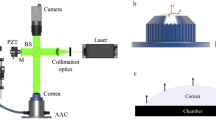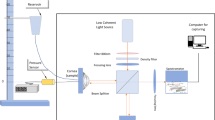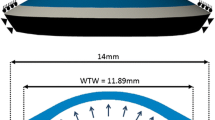Abstract
Background
Pre and post-operative clinical assessment of the patients is generally based on the corneal tomographic data. However, techniques are required to assess the patient-specific structural and pathological changes for better therapeutic and surgical interventions. The birefringence of the human cornea is the manifestation of mechanics-structure interrelationship and is an important property to quantify corneal abnormalities.
Objective
The present paper aims to understand the mechanics-structure interrelationship of the human cornea.
Methods
For the first time, the birefringence behavior of the human cornea is explored using the digital photoelasticity technique and finite element method. The experimentally obtained phase maps of twenty corneas were analyzed at 0 and 20 mm Hg pressure. Finally, a qualitative comparison of the results from experiments and simulations was carried out.
Results
Features like isotropic points, retardation maps, etc., were extracted from the photoelastic phase maps. The pressure loading did not create a statistically significant change in the average retardation of the central 4 mm cornea. However, the isotropic points were distributed differently in the tested corneas, depicting inter-individual variability in corneal birefringence. The authors found that the steepness or flatness of the corneal curvature decides the location of the isotropic points.
Conclusions
The inter-individual variability in corneal birefringence arises from the complex interplay of the cornea's microstructure, curvature, and stress distribution. The authors foresee the applicability of digital photoelasticity in clinics for diagnostic and monitoring purposes due to its operational simplicity and data accuracy.











Similar content being viewed by others
References
Fanjul-Vélez F, Pircher M, Baumann B et al (2010) Polarimetric analysis of the human cornea measured by polarization-sensitive optical coherence tomography. J Biomed Opt 15:056004-1–56010. https://doi.org/10.1117/1.3486540
Donohue DJ, Stoyanov BJ, Mccally RL, Farrell RA (1995) Numerical modeling of the cornea ’ s lamellar structure and birefringence properties. J Opt Soc Am A 12:1425–1438. https://doi.org/10.1364/JOSAA.12.001425
Bone RA, Draper G (2007) Optical anisotropy of the human cornea determined with a polarizing microscope. Appl Opt 46:8351–8357. https://doi.org/10.1364/AO.46.008351
Götzinger E, Pircher M, Sticker M et al (2004) Measurement and imaging of birefringent properties of the human cornea with phase-resolved, polarization-sensitive optical coherence tomography. J Biomed Opt 9:94. https://doi.org/10.1117/1.1629308
Stanworth A, Naylor EJ (1950) The Polarization optics of isolated cornea. B Journal of Opt 34:201–211. https://doi.org/10.1136/bjo.34.4.201
Knighton RW, Huang X-R, Cavuoto LA (2008) Corneal birefringence mapped by scanning laser polarimetry. Opt Express 16:13738. https://doi.org/10.1364/oe.16.013738
Kaplan D, Bettelheim FA (1972) Dynamic Rheooptical Behavior of isolated cornea. Biophys J 12:1630–1641. https://doi.org/10.1016/S0006-3495(72)86186-1
Nyquist GW (1968) Stress-induced birefringence of the cornea. Am J Ophthalmol 65:398–404. https://doi.org/10.1016/0002-9394(68)93090-0
Richhariya A, Verma Y, Rao DK et al (2014) Effect of Intraocular Pressure and Anisotropy on the Optical Properties of the Cornea: A Study Using Polarization Sensitive Optical Coherence Tomography. Asia-Pacific Journal of Ophthalmology 3:348–353. https://doi.org/10.1097/apo.0000000000000015
Misson GP (2007) Circular polarization biomicroscopy: A method for determining human corneal stromal lamellar organization in vivo. Ophthalmic Physiol Opt 27:256–264. https://doi.org/10.1111/j.1475-1313.2007.00482.x
Antony SJ (2015) Imaging shear stress distribution and evaluating the stress concentration factor of the human eye. Sci Rep. https://doi.org/10.1038/srep08899
Sobczak M, Asejczyk M (2021) Birefringent properties of the cornea measured by a Mueller type polarimeter in healthy adults and children. Biomed Opt Express 12:7872. https://doi.org/10.1364/BOE.440274
Zandman F (1966) Photoelastic effect of the living eye. Exp Mech 6:19A-22A. https://doi.org/10.1007/bf02327314
Ramesh K, Ramakrishnan V (2016) Digital photoelasticity of glass: A comprehensive review. Opt Lasers Eng 87:59–74. https://doi.org/10.1016/j.optlaseng.2016.03.017
Zhang Y, Chen Y (2021) Topography-guided corneal surface laser ablation combined with simultaneous accelerated corneal collagen cross-linking for treatment of keratoconus. BMC Ophthalmol 21:1–9. https://doi.org/10.1186/s12886-021-02042-x
Vinciguerra P, Epstein D, Albè E et al (2007) Corneal topography-guided penetrating keratoplasty and suture adjustment: New approach for astigmatism control. Cornea 26:675–682. https://doi.org/10.1097/ICO.0b013e3180553bb2
Gururani H, Richhariya A, Ramji M, Chinthapenta V (2021) Implications of the structure-property relationship on the optomechanical characterization of the cornea : A review. Optik (Stuttg) 232:166529. https://doi.org/10.1016/j.ijleo.2021.166529
Nakagawa T, Maeda N, Kosaki R et al (2009) Higher-order aberrations due to the posterior corneal surface in patients with keratoconus. Invest Ophthalmol Vis Sci 50:2660–2665. https://doi.org/10.1167/iovs.08-2754
Pallikaris IG, Kymionis GD, Astyrakakis NI (2001) Corneal ectasia induced by laser in situ keratomileusis. J Cataract Refract Surg 27:1796–1802. https://doi.org/10.1016/S0886-3350(01)01090-2
Roberts CJ, Dupps WJ (2014) Biomechanics of corneal ectasia and biomechanical treatments. J Cataract Refract Surg 40:991–998. https://doi.org/10.1016/j.jcrs.2014.04.013
Greenfield DS, Knighton RW (2001) Stability of Corneal Polarization Axis Measurements for Scanning Laser Polarimetry. Ophthalmology 108:1065–1069. https://doi.org/10.1016/S0161-6420(01)00569-3
Timoshenko S, Goodier JN (1934) Theory of elasticity
Ru F (2005) White-to-White Corneal Diameter Normal Values in Healthy Humans Obtained With the Orbscan II Topography System 24:259–261
Ramji M, Ramesh K (2010) Adaptive quality guided phase unwrapping algorithm for whole-field digital photoelastic parameter estimation of complex models. Strain 46:184–194. https://doi.org/10.1111/j.1475-1305.2008.00431.x
Petrucci G (1997) Full-field automatic evaluation of an isoclinic parameter in white light. Exp Mech 37:420–426. https://doi.org/10.1007/BF02317308
Zhang Y, Wang S, Ji G, Dong Z (2014) an Improved Quality Guided Phase Unwrapping Method and Its Applications To Mri. Progress In Electromagnetics Research 145:273–286. https://doi.org/10.2528/pier14021005
Ramesh K, Yadav AK, Pankhawalla VA (1995) Plotting of fringe contours from finite element results. Commun Numer Methods Eng 11:839–847. https://doi.org/10.1002/cnm.1640111008
Abass A, Hayes S, White N et al (2015) Transverse depth-dependent changes in corneal collagen lamellar orientation and distribution. J R Soc Interface 12:20140717–20140717. https://doi.org/10.1098/rsif.2014.0717
Li LY, Tighe B (2006) The anisotropic material constitutive models for the human cornea. J Struct Biol 153:223–230. https://doi.org/10.1016/j.jsb.2005.10.014
Pandolfi A, Holzapfel GA (2008) Three-dimensional modeling and computational analysis of the human cornea considering distributed collagen fibril orientations. J Biomech Eng 130:061006-1–61012. https://doi.org/10.1115/1.2982251
Ramesh K (2002) Digital Photoelasticity: Advanced Techniques and Applications. Springer
Jaronski JW, Kasprzak HT (2003) Linear birefringence measurements of the in vitro human cornea. Ophthalmic Physiol Opt 23:361–369. https://doi.org/10.1046/j.1475-1313.2003.00128.x
van Blokland GJ, Verhelst SC (1987) Corneal polarization in the living human eye explained with a biaxial model. J Opt Soc Am A 4:82–90. https://doi.org/10.1364/JOSAA.4.000082
Farrell RA, Rouseff D, McCally RL (2005) Propagation of polarized light through two- and three-layer anisotropic stacks. J Opt Soc Am A 22:1981. https://doi.org/10.1364/JOSAA.22.001981
Wilson A, Jones J, Tyrer JR, Marshall J (2020) An interferometric ex vivo study of corneal biomechanics under physiologically representative loading, highlighting the role of the limbus in pressure compensation. Eye and Vision 7:43. https://doi.org/10.1186/s40662-020-00207-1
Mangal SK, Ramesh K (1999) Determination of characteristic parameters in integrated photoelasticity by phase-shifting technique. Opt Lasers Eng 31:263–278. https://doi.org/10.1016/S0143-8166(99)00027-5
Simonini I, Pandolfi A (2015) Customized finite element modelling of the human cornea. PLoS ONE 10:1–23. https://doi.org/10.1371/journal.pone.0130426
Liu X, Wang L, Ji J et al (2014) A Mechanical model of the cornea considering the crimping morphology of collagen fibrils. Invest Ophthalmol Vis Sci 55:2739–2746. https://doi.org/10.1167/iovs.13-12633
Meek KM, Boote C (2004) The organization of collagen in the corneal stroma. Exp Eye Res 78:503–512. https://doi.org/10.1016/j.exer.2003.07.003
Acknowledgements
This study was funded by the intramural funds of LV Prasad Eye Institute (LVPEI), Hyderabad; and partially supported under Prime Minister Doctoral Research Fellowship grant (to author HG) by the Department of Science and Technology, India, Science, and Engineering Research Board, India, Confederation of Indian Industries, India, the Government of India & LVPEI. The author HG acknowledges Dr. Ashutosh Richhariya & Utkarsha Dasmantarao for providing insights in optics and Jagadeesh Rao for load cell calibration.
Author information
Authors and Affiliations
Corresponding author
Ethics declarations
Ethical Declaration
The current study is performed with the ethical approval from the institutional review board of L V Prasad Eye Institute, Hyderabad (Ethics. Ref. No. 05–19-260, Dt. 14 May 2019), Institutional Ethics committee of IIT Hyderabad, Hyderabad (IEC Protocol No. IITH/IEC/2019/05/14, Dt. 2 May 2019).
Conflict of Interest
The authors declare that they do not have any conflict of interest.
Additional information
Publisher's Note
Springer Nature remains neutral with regard to jurisdictional claims in published maps and institutional affiliations.
Supplementary Information
Below is the link to the electronic supplementary material.
Rights and permissions
Springer Nature or its licensor holds exclusive rights to this article under a publishing agreement with the author(s) or other rightsholder(s); author self-archiving of the accepted manuscript version of this article is solely governed by the terms of such publishing agreement and applicable law.
About this article
Cite this article
Gururani, H., Chittajallu, S.N.S.H., Ramji, M. et al. An In-Vitro Investigation on the Birefringence of the Human Cornea Using Digital Photoelasticity. Exp Mech 63, 205–219 (2023). https://doi.org/10.1007/s11340-022-00910-1
Received:
Accepted:
Published:
Issue Date:
DOI: https://doi.org/10.1007/s11340-022-00910-1




